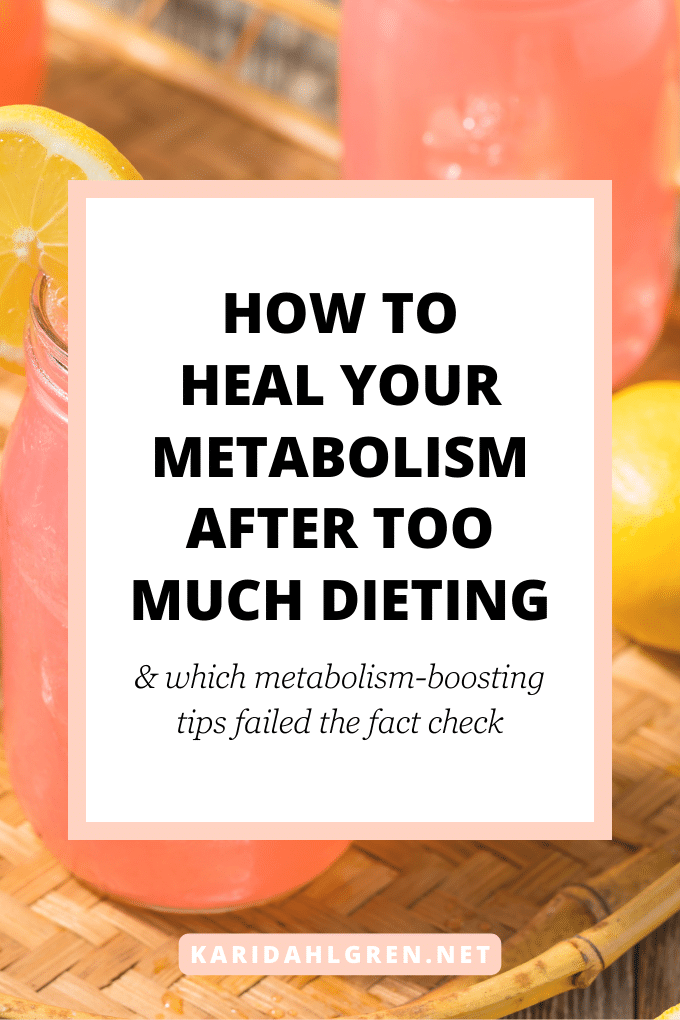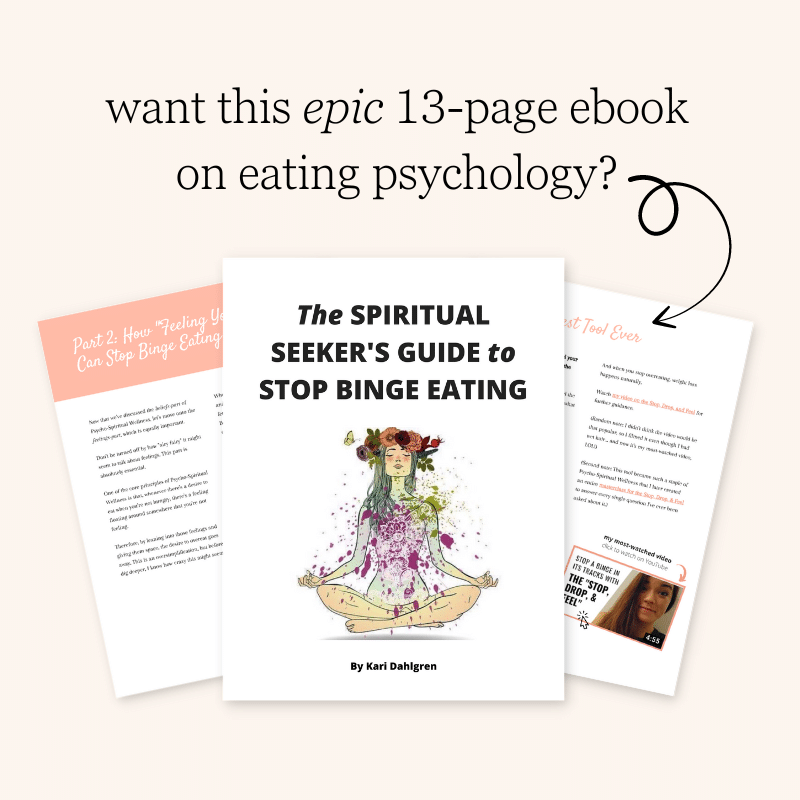
If you’ve ever wondered how to fix a damaged metabolism after dieting, you’re not alone. Many people find themselves caught in a zero-sum game when it comes to weight loss: eating less leads to burning fewer calories, which in turn means you have to eat even less to continue losing weight. This cycle can feel like a never-ending treadmill, ultimately unsustainable and frustrating.
In this article, we’ll dive deep into how metabolism works, exploring why it tends to slow down on a restrictive diet and what steps you can take to repair a metabolism that’s been thrown off balance by dieting.
At the end, I’ll address some common metabolism-boosting tips and put them to the test. Stay tuned to see which tips passed the fact check.
How Metabolism Works
Metabolism refers to the sum total of all chemical reactions that take place in the body, including the process of converting food into energy. Although typical advice for weight loss is to eat less, it is a well-documented phenomenon that metabolism slows down after dieting and restricting calorie intake.[1], [2], [3]
Before digging into the steps on how to fix a damaged metabolism after dieting, here are some important phrases to know:
- A calorie is a unit that measures energy. In the context of metabolism and nutrition, the terms ‘calorie’ and ‘energy’ are used interchangeably.
- Resting Metabolic Rate refers to the amount of energy needed to maintain basic physiological functions, such as breathing and circulation, while at rest. It accounts for the majority of your daily calorie expenditure.
- Thermic Effect of Food refers to the energy required to digest, absorb, and metabolize the food you eat. It accounts for about 10% of your total calorie expenditure.[4] Common weight loss advice is to eat foods with a high thermic effect.
Weight loss is a complex process influenced by many factors, including diet, exercise, genetics, lifestyle, and psychology. Focusing solely on the thermic effect of food oversimplifies the process and may lead to imbalanced nutrition.
Other factors that influence metabolism include and are not limited to:
- Muscle mass: Muscle tissue is more metabolically active than fat tissue, meaning it burns more calories even at rest. People with a higher proportion of muscle mass tend to have a higher metabolic rate.
- Age: Metabolism tends to decrease with age, mainly due to a decline in muscle mass and hormonal changes.[5]
- Diet: What you eat and how much you eat both influence your metabolism.
- Overeating: Overfeeding causes a short-term increase in metabolism as the body attempts to compensate for the excess energy consumed.[6] In the long-term, however, excessive intake of food can lead to metabolic syndrome and weight gain.
- Undereating: When calorie intake is restricted, the body adapts to conserve energy by slowing down metabolism. This is discussed at length in the next section.
- Hormonal factors: Imbalances in hormones, such as hypothyroidism, can lead to a slower metabolism.[7]
- Genetics: Some individuals may have a naturally higher or lower metabolic rate due to genetic factors. That said, genetic influence on metabolism is relatively small compared to lifestyle and environmental factors.[8]
- Physical activity: Exercise and all movement directly impact the calories you burn.
If you’re interested in learning how to fix a damaged metabolism after dieting, perhaps you want to burn more calories while at rest, or maybe your weight loss journey has plateaued. A great place to start your wellness journey is understanding why diets don’t work and how they slow down your metabolism in the first place.
Why Metabolism Slows Down After Dieting
When you consume fewer calories than needed, your body instinctively slows down its metabolic rate to preserve energy—a phenomenon referred to as adaptive thermogenesis.[9] This process is partly to blame for the weight regain that often occurs after restrictive dieting.[10]
Because of the highly adaptive nature of the human body, attempts to manipulate body weight are often subject to biological pushback. For example, during the famous Minnesota Starvation Experiment, participants severely restricted their diets and, as a result, significantly decreased their metabolic rates.[11]
During the refeeding phase, participants not only returned to their pre-starvation weight levels, but a larger portion of this regained weight consisted of body fat.[12] This shift in body composition suggests that their metabolism had not fully recovered to its pre-starvation rate.
Not only does metabolism slow down when calories are restricted, but the body’s hormones adjust to motivate eating with an increase in ghrelin (the hunger hormone) and a decrease in leptin (one of the fullness hormones).[13]
These powerful biological adaptations underscore the restrict-binge cycle, where periods of undereating are often followed by periods of overeating. Furthermore, the effects of restriction are not merely biological as dieting has psychological consequences as well, such as preoccupation and obsession with food.
How to Fix a Damaged Metabolism After Dieting
Instead of learning how to fix a damaged metabolism only to hop back on another restrictive diet and repeat the cycle, there is a better way. Listening to the body’s hunger and fullness signals can encourage the body to settle on its natural weight and, over time, encourage a healthy weight to emerge.
Here are some evidence-based steps for learning how to fix a damaged metabolism after dieting:
1. Stop Trying to Eat as Little as Possible
One of the fundamental steps in repairing a damaged metabolism is to let go of the mindset that encourages eating as little as possible. If the Minnesota Starvation Experiment taught us anything, it’s that the human body is highly adaptive and wired to rebel against starvation by motivating overeating.
Research supports the idea that intuitive eating, a practice that encourages listening to and honoring your body’s hunger and fullness cues, can lead to improved metabolic fitness and a more stable weight than dieting.[14] Instead of constantly losing and gaining weight—a phenomenon called weight cycling that has its own negative health consequences—intuitive eating leads to more balance.
2. Eat Protein in a Balanced, Intuitive Manner
Common advice for boosting metabolism is to eat more protein. While this advice isn’t inherently wrong, it can easily be misconstrued by all-or-nothing dieters—including myself before I gave up dieting and healed my relationship with food!
While protein is a crucial macronutrient for muscle repair, metabolic function, and satiety, forcing yourself to eat protein when you’re not actually craving it can be counterproductive. Excessive consumption of protein, particularly from animal sources, has been linked to an increased risk of metabolic syndrome, heart disease, and other unwanted side effects.[15]
Furthermore, an overly rigid focus on protein intake can diminish the joy and pleasure of eating, both of which are crucial for overall well-being.[16] Food is not just fuel—it’s also a source of enjoyment and satisfaction.
When the pleasure aspect of eating is neglected, there’s a risk of turning to hyperpalatable foods, such as those high in sugar and fat, to fill the void (i.e. “eating for pleasure”). This can lead to overeating and further disrupt metabolic balance.
3. Reduce Stress
Reducing stress is a crucial component in repairing a damaged metabolism after dieting. Stress can have a significant impact on metabolic function, primarily through the release of cortisol, a hormone that can increase appetite and promote fat storage, particularly in the abdominal area.[17] High levels of cortisol over time can also lead to insulin resistance, a key factor in metabolic syndrome and type 2 diabetes.
To support metabolic health, it’s essential to incorporate stress-reduction techniques into your daily routine, such as:
- Mindful Meditation: Spending a few minutes each day in quiet reflection or guided meditation can help calm the mind and reduce stress levels.
- Regular Exercise: Engaging in physical activities that you enjoy, such as walking, yoga, or dancing, can be an effective way to relieve stress and improve overall well-being.
- Deep Breathing Exercises: Practicing deep breathing techniques, such as diaphragmatic breathing or the 4-7-8 method, can help activate the body’s relaxation response and reduce stress.
By incorporating stress-reduction strategies into your life, you can support your body’s metabolic processes and promote a sense of balance and well-being.
4. Exercise in Ways That You Enjoy
As we continue on the quest to fix a damaged metabolism after dieting, exercise plays a vital role. Strength training, in particular, is associated with a higher resting metabolic rate due to the increased muscle mass that requires more energy to maintain.
However, it’s crucial to find a balance, as overexercising can lead to stress, decreased glucose tolerance, and mental health issues, all of which can counteract the benefits of exercise.[18], [19], [20] The key is to engage in intuitive movement, or exercising in ways that feel good and enjoyable to you.
This approach ensures that physical activity remains a source of pleasure and stress relief, rather than becoming another stressor. Whether it’s dancing, hiking, yoga, or any other form of movement that brings you joy, listening to your body and honoring its needs can help restore metabolic balance and contribute to overall well-being.
5. Focus on Overall Wellness
Because there are many other factors that contribute to metabolism, a focus on overall wellness can help fix a damaged metabolism after dieting. Here are some important tips to consider:
- Hydrate: Drinking enough water is essential for optimal metabolic function. Proper hydration aids in the digestion and transportation of nutrients.
- Get Enough Sleep: Quality sleep is crucial for metabolic health. Lack of sleep can disrupt the balance of hunger-regulating hormones, leading to increased appetite and potential weight gain.[21]
- Practice Mindful Eating: Mindful eating involves paying attention to the experience of eating, which can enhance digestion and satisfaction. By eating mindfully, you’re more likely to recognize your body’s hunger and fullness signals, reducing the likelihood of overeating.
- Foster Gut Health: The link between gut health and metabolic health is new, emerging, and promising so far, though more research is needed.[22] Consuming a diet rich in fiber, probiotics, and prebiotics can support gut health and, in turn, aid in maintaining a healthy metabolism.
Notice that these tips don’t involve eating spicy foods or paying attention to the thermic effect of food. While there is some science that supports these tips rampant in popular culture, not many of them passed a rigorous fact check.
Fact-Checking Common Metabolism-Boosting Tips
The best way to fix a damaged metabolism after dieting is to stop cyclical patterns of undereating and overeating and allow the body to naturally settle upon its natural weight. Furthermore, it’s important to avoid following tips for boosting metabolism that aren’t backed by science.
I took some of the most common tips for boosting metabolism and checked clinical evidence to see if they hold up to scientific scrutiny. Some tips straight-up failed the fact-check while others passed with some precautions.
Failed Fact-Checking
Here’s a metabolism-boosting tip that failed the fact check:
- Eating thermogenic foods promotes weight loss—failed fact-checking. There is no doubt that some foods require more calories to digest than others. However, research studies show no association between TEF and clinically significant weight loss.[23], [24] Even a recent 2019 review study found a lack of evidence in relation to TEF and weight management.[25]
While that tip failed the fact check, there were several tips that passed fact-checking but should be met with caution as they are associated with potential consequences.
Passed Fact-Checking with Precautions
Here are some metabolism-boosting tips that passed the fact check with precautions:
- Eat plenty of protein—passed fact-checking with precautions. Consuming a diet high in protein is associated with increased metabolism.[26] However, the same study also mentions that a high-protein diet may exacerbate the development of metabolic disease. Furthermore, high intake of protein was actually associated with more weight gain than low protein intake in another study.[27]
- Eat spicy foods—passed fact-checking with precautions. Spicy foods are well-known for their metabolism-boosting effects, but a recent 2022 review study shows a strong link between spicy food consumption and esophageal cancer, gastric cancer, and gallbladder cancer.[28] Overconsuming spicy foods solely for the sake of boosting metabolism may do more harm than good.
- Drink coffee—passed fact-checking with precautions. Coffee has strong metabolism-boosting properties.[29] It is also an appetite suppressant.[30] Although coffee boosts metabolism, it may also perpetuate the restrict-binge cycle, where the appetite-suppressing effects of coffee lead to reduced food intake initially, but may result in overeating later when hunger intensifies.
Finally, there are a few solid metabolism-boosting tips that passed the fact check and deserve the credit they have. For optimal wellness, follow these tips with balance in mind.
Passed Fact-Checking
Here are some metabolism-boosting tips that passed the fact check:
- Train with heavy weights—passed fact-checking. Having more muscle is associated with a higher resting metabolic rate, which means you burn more calories even at rest.[31] An abundance of clinical evidence shows that long-term resistance training improves resting metabolic rate.[32], [33]
- Do high-intensity interval training—passed fact-checking. HIIT is well-known to improve metabolic rate.[34] However, one meta-analysis found that combining aerobic exercise with resistance exercise did not increase RMR while resistance exercise alone did increase RMR.[33] This may imply that—in regards to boosting metabolism—resistance training alone works best.
If you’re the type of person that enjoys resistance training and lifting heavy weights, you’re in luck because it can benefit metabolism. This isn’t to say that people who hate weight-lifting need to start, either. The best exercise is sustainable exercise. If you move your body in ways that feel good, you’ll be in great shape.
Healing Your Metabolism After Dieting
Fixing a damaged metabolism after dieting is not about quick fixes or following the latest trends. It’s about understanding the intricate dance between your body’s biological needs and your lifestyle choices. By adopting a holistic approach that includes intuitive eating and exercise with a focus on overall wellness, you can encourage your body to find its natural balance.
Remember, your metabolism is not your enemy; it’s a vital part of your body’s intricate system, working tirelessly to keep you alive and thriving. Instead of fighting against it, let’s learn to work with it.
To learn more about making peace with food, download my free ebook below, which expands on all my core philosophies:



